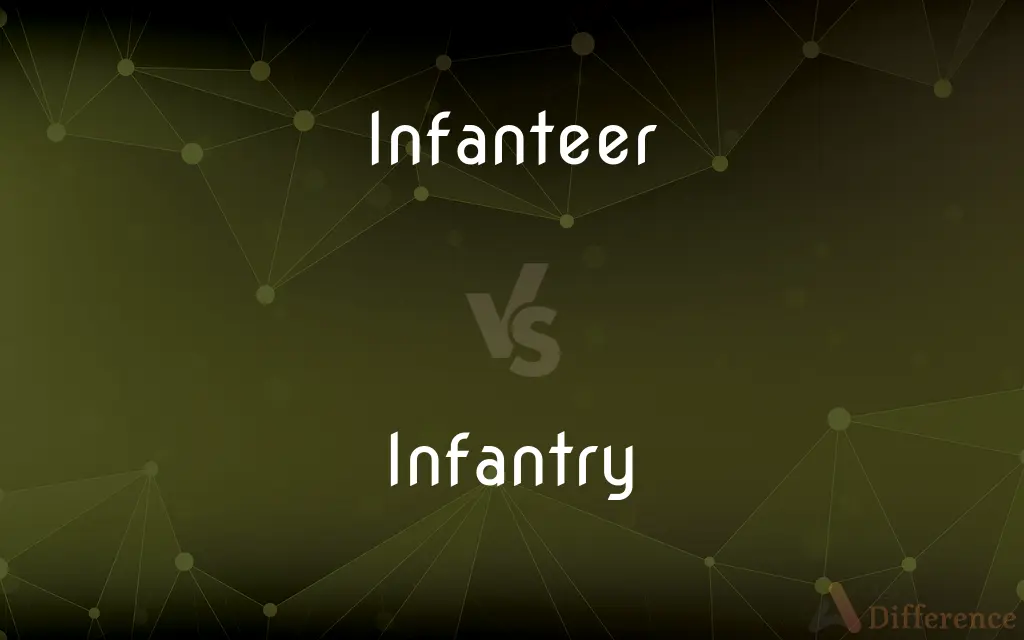Infanteer vs. Infantry — What's the Difference?
By Urooj Arif & Fiza Rafique — Updated on April 5, 2024
An infanteer is a soldier within the infantry branch, while infantry refers to the military unit itself, composed of such soldiers.

Difference Between Infanteer and Infantry
Table of Contents
ADVERTISEMENT
Key Differences
An infanteer refers to an individual soldier trained to fight on foot within the infantry, which is the branch of an army specializing in ground combat. Infantry, on the other hand, encompasses the entire unit or branch of these soldiers, focusing on fighting primarily on foot but may also include mechanized or motorized formations.
Infanteers are trained in various combat skills, including the use of firearms, hand-to-hand combat, and operating in different terrains and environments. Infantry units are structured to leverage these skills collectively, forming the backbone of ground forces capable of various offensive and defensive operations.
The role of an infanteer is characterized by close-quarters combat, operating weapons systems, and participating in reconnaissance missions. Infantry units, however, operate on a larger scale, engaging in battles that require coordination of these individual roles to secure territories or achieve strategic objectives.
Infanteers often carry personal weaponry and are equipped for rapid mobility and versatility in battle. The infantry, as a larger entity, encompasses various specialized groups, including light, airborne, and mechanized infantry, each tailored to specific operational needs.
The distinction between infanteer and infantry is crucial in understanding military operations. An infanteer represents the fundamental element of the infantry, which collectively forms a vital part of the army's capability to project power and secure objectives on the ground.
ADVERTISEMENT
Comparison Chart
Definition
An individual soldier trained for ground combat
A military unit or branch specializing in ground combat
Role
Close-quarters combat, operating weapons, reconnaissance
Engaging in battles, securing territories, strategic objectives
Training
Combat skills, use of firearms, survival in various environments
Collective coordination, specialized formations (light, airborne, mechanized)
Equipment
Personal weaponry, geared for mobility and versatility
Includes a variety of weaponry and specialized equipment for different sub-units
Scale
Individual level
Unit or branch level
Compare with Definitions
Infanteer
Operates within infantry units, executing orders and engaging in close combat.
The infanteers led the charge, moving swiftly through the enemy lines.
Infantry
Essential for capturing and holding ground, often determining the success of military campaigns.
The success of the campaign depended heavily on the infantry's ability to hold captured territories.
Infanteer
Carries personal firearms, grenades, and other combat gear.
The infanteer's backpack was filled with essential gear for extended missions.
Infantry
Engages in a wide range of military operations, from assaults to defensive stands.
The infantry's versatility allowed it to adapt quickly to the changing battlefield.
Infanteer
Specializes in hand-to-hand combat, marksmanship, and survival tactics.
Every infanteer was required to complete rigorous marksmanship training.
Infantry
Can be categorized into light, airborne, and mechanized infantry, each with specific roles.
The airborne infantry was airlifted behind enemy lines for a surprise assault.
Infanteer
A soldier trained to engage in ground combat as part of an infantry unit.
The infanteer mastered the art of navigating rough terrain silently.
Infantry
A military branch composed of soldiers trained for close combat on foot.
The infantry unit was deployed to secure the strategic hilltop.
Infanteer
Represents the primary combat force within the infantry, crucial for tactical operations.
Infanteers are often the first to engage the enemy, playing a critical role in the outcome of battles.
Infantry
Includes soldiers with various specializations, forming a versatile fighting force.
The infantry included not just riflemen, but also medics and engineers.
Infanteer
A soldier employed in any infantry role; an infantryman.
The appointment of an infanteer from The Highlanders as the Sovereign's Piper shows that the events following Culloden are no longer raw in the memory. [http://www.royal.gov.uk/output/page3370.asp official web site of the British Monarchy]
Infantry
Infantry is an army specialization whose personnel engage in military combat on foot, distinguished from cavalry, artillery, and armored forces. Also known as foot soldiers, infantrymen or infanteer, infantry traditionally rely on traveling by foot between combats as well, but may also use mounts (mounted infantry), military vehicles (motorized, and mechanized infantry), watercraft (naval infantry), or aircraft (airborne infantry) for between-combat mobility and logistics.
Infantry
The branch of an army made up of units trained to fight on foot.
Infantry
Soldiers armed and trained to fight on foot
The general ordered his infantry to attack.
Infantry
A unit, such as a regiment, of such soldiers
Company B of the 7th Infantry.
Infantry
Soldiers who fight on foot (on land), as opposed to cavalry and other mounted units, regardless of external transport (e.g. airborne).
Infantry
(uncountable) The part of an army consisting of infantry soldiers, especially opposed to mounted and technical troops
Infantry
A regiment of infantry
Infantry
A body of children.
Infantry
A body of soldiers serving on foot; foot soldiers, in distinction from cavalry.
Infantry
An army unit consisting of soldiers who fight on foot;
There came ten thousand horsemen and as many fully-armed foot
Common Curiosities
How do infanteers communicate during operations?
They use a combination of radio communications, hand signals, and sometimes written messages to maintain stealth and coordination.
How does infantry contribute to national defense?
Infantry units are crucial for defense operations, capable of engaging the enemy directly, securing borders, and responding to threats on the ground.
Can infantry operate vehicles?
Yes, especially within mechanized and motorized infantry units, soldiers are trained to operate armored vehicles and support equipment.
What are the physical requirements for an infanteer?
High physical fitness levels are required for endurance, strength, and agility to navigate diverse and challenging environments.
What type of training does an infanteer undergo?
Training includes basic combat skills, specialized weaponry usage, tactical maneuvers, and survival skills in hostile environments.
How does the infantry adapt to urban warfare?
Infantry units undergo specialized training for urban combat, learning to navigate and fight in densely populated areas with unique tactical challenges.
What is the difference between light and mechanized infantry?
Light infantry is optimized for rapid mobility and flexibility, often in difficult terrain, while mechanized infantry uses armored vehicles for transport and support.
What makes an infanteer different from other soldiers?
An infanteer specializes in ground combat within the infantry, distinguished by close-quarters combat training and the ability to operate in various terrains.
What is the historical significance of the infantry?
Infantry has been a fundamental combat unit throughout history, often playing decisive roles in battles and shaping the outcome of wars.
What are the career prospects for an infanteer after military service?
Many find careers in law enforcement, private security, and defense contracting, leveraging their combat training and leadership skills.
How are infantry units organized?
They are structured into squads, platoons, companies, battalions, and brigades, each with specific roles and commanded by officers and non-commissioned officers.
Are there any gender restrictions for becoming an infanteer?
While historically male-dominated, many modern armies now allow women to serve as infanteers, subject to meeting the same physical and skill requirements.
Can infanteers serve in peacekeeping missions?
Yes, they often participate in international peacekeeping operations, providing security, humanitarian aid, and supporting the enforcement of peace agreements.
What role does technology play in modern infantry?
Technology enhances the capabilities of the infantry with advanced weapons, communication systems, and reconnaissance drones, increasing effectiveness and situational awareness.
How do modern conflicts influence infantry tactics?
Infantry tactics continuously evolve in response to new threats, technologies, and battlefield conditions, emphasizing adaptability and innovation.
Share Your Discovery

Previous Comparison
Invertase vs. Sucrase
Next Comparison
Rubbish vs. DustbinAuthor Spotlight
Written by
Urooj ArifUrooj is a skilled content writer at Ask Difference, known for her exceptional ability to simplify complex topics into engaging and informative content. With a passion for research and a flair for clear, concise writing, she consistently delivers articles that resonate with our diverse audience.
Co-written by
Fiza RafiqueFiza Rafique is a skilled content writer at AskDifference.com, where she meticulously refines and enhances written pieces. Drawing from her vast editorial expertise, Fiza ensures clarity, accuracy, and precision in every article. Passionate about language, she continually seeks to elevate the quality of content for readers worldwide.















































